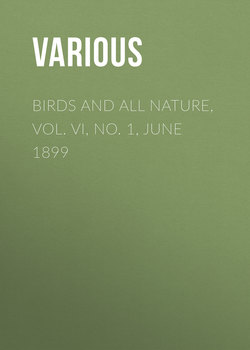Читать книгу Birds and All Nature, Vol. VI, No. 1, June 1899 - Various - Страница 3
WESTERN YELLOW-THROAT
Оглавление(Geothlypis trichas occidentalis.)
The birds are here, for all the season's late.
They take the sun's height, an' don' never wait;
Soon's he officially declares it's spring,
Their light hearts lift 'em on a north'ard wing,
An' th' aint an acre, fur ez you can hear,
Can't by the music tell the time o' year.
– Lowell.
THIS common, but beautiful resident of the western United States begins to arrive about the middle of April and leaves during the month of September. It is one of the most conspicuous of the warbler family, is very numerous and familiar, and is decked with such a marked plumage that it cannot fail to be noticed. The adult male is olive-green above, becoming browner on the nape. The female is duller in color than the male without black, gray, or white on head, which is mostly dull brownish. The yellow of throat is much duller than in the male. The young are somewhat like the adult female. This is said to be the prevailing form in Illinois and Indiana, the larger number of specimens having the more extensively yellow lower parts of the western form, though there is much variation.
This little fellow is found among the briars or weed-stalks, in rose bushes and brambles, where it sings throughout the day. Its nest, generally built between upright weed-stalks or coarse grass in damp meadow land, is shaped like a cup, the opening at the top. The eggs vary from four to six, and are of a delicate pinkish-white, the larger end marked by a ring of specks and lines of different shades of brown. The western yellow-throat inhabits the Mississippi valley to the Pacific coast. It is found as far north as Manitoba; south in winter from the southern United States, through central and western Mexico to Guatemala. With a few exceptions the warblers are migratory birds, the majority of them passing rapidly across the United States in the spring on the way to the northern breeding-grounds. It is for this reason that they are known to few except the close observers of bird life, though in season they are known to literally swarm where their insect food is most plentiful – "always where the green leaves are, whether in lofty tree-top, by an embowered coppice, or budding orchard. When the apple trees bloom the warblers revel among the flowers, vying in activity and numbers with the bees; now probing the recesses of a blossom for an insect which has effected lodgment there, then darting to another, where, poised daintily upon a slender twig, or suspended from it, he explores, hastily, but carefully for another morsel. Every movement is the personification of nervous activity, as if the time for the journey was short; and, indeed, such appears to be the case, for two or three days, at most, suffice some species in a single locality; a day spent in gleaning through the woods and orchards of one neighborhood, with occasional brief siestas among the leafy bowers, then the following night in continuous flight toward its northern destination, is probably the history of every individual of the moving throng."
